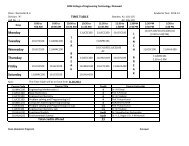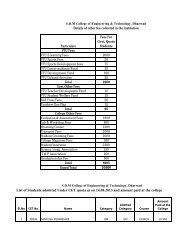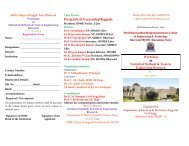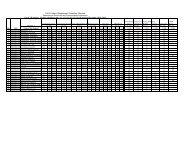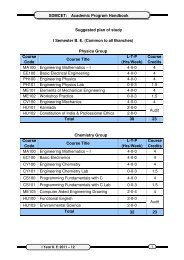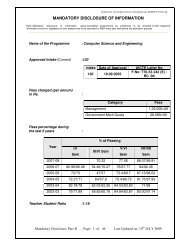SDM Utsav Souvenir - SDMCET
SDM Utsav Souvenir - SDMCET
SDM Utsav Souvenir - SDMCET
- TAGS
- utsav
- souvenir
- sdmcet
- sdmcet.ac.in
Create successful ePaper yourself
Turn your PDF publications into a flip-book with our unique Google optimized e-Paper software.
3. Automatic conveyors: Automatic conveyors are used to transport components or material from one location to another location without<br />
manual push and pull to avoid operator fatigue & also ergonomics.<br />
Different types of automatic conveyors are slat conveyors, over head conveyors, single chain & double chain conveyors and roller conveyors.<br />
4. Wheel Alignment machine to check the Toe-in, castor & camber of the vehicle (front axle and wheels)<br />
5. Number punching machines are used for punching numbers on components (and vehicles) for identification which also works on pneumatics<br />
which is widely used in all manufacturing industries.<br />
6. Roller testing machines are used for vehicle testing operation by all the automobile manufactures.<br />
7. Automatic vacuum grippers for lifting various components for assembly.<br />
8. Engine manufacturing- Cylinder head shimming selection machine, very important in controlling emission of engines.<br />
SCADA - Supervisory Control and Data Acquisition<br />
Supervisory control & data acquisition is widely used now a days in manufacturing industries to store data and also to monitor a track of the<br />
existing process.<br />
Robotics:<br />
Robot is a reprogrammable, multifunctional manipulator designed to move material, parts, tools, or specialized devices. This is obtained<br />
through various programmed motions for the performance of a variety of tasks.<br />
Robots can perform jobs more efficiently and quicker than humans with consistent quality. Robots never get sick, can work 24 hrs a day, 7 days a<br />
week. They are very useful in repetitive operations involving high precision, don't get bored, so work that is repetitive and unrewarding is not a<br />
problem.<br />
Industrial robots are now found in manufacturing industries in important applications like...<br />
1. Spot welding, CO2 welding, arc welding operatons for sheet metal components with high precession and accuracy. For example passenger<br />
vehicle plants use Robots for door subassembly, roof subassembly, main assembly of A-pillar, B-pillar, side panels & roof.<br />
Maruti's weld shop and Tata motor's passenger vehicle body shop plant are completely automated with robots for spot welding for various<br />
components like fender subassembly, door sub-assy, bonnet sub-assy.<br />
2. Loading & unloading of components on the fixture for performing Sub-assembly or assembly to eliminate operator fatigue in manual lifting<br />
3. Robots are used in glass gluing system to maintain accuracy and avoid wastages<br />
Vehicle front & back door glass gluing is done using programised robots.<br />
4. Robots are widely used in paint shop like spray painting, cathodic paint, Polishing<br />
M&M uses Robotic sprayer in it's paint shops for painting of all SUVs and passenger cars.<br />
5. Material handling robots are widely used in warehouse for Pick and place<br />
For example: Ford India plant is using Palletized robots for stacking products on pallets.<br />
Current limits<br />
Many roles for humans in industrial processes presently lie beyond the scope of automation. Human-level pattern recognition, language<br />
recognition, and language production ability are well beyond the capabilities of modern mechanical and computer systems. Tasks requiring<br />
subjective assessment or synthesis of complex sensory data, such as scents and sounds, as well as high-level tasks such as strategic planning,<br />
currently require human expertise. In many cases, the use of humans is more cost-effective than mechanical approaches even where<br />
automation of industrial tasks is possible.<br />
Impact of Automation on Employment<br />
It was believed, for years together that automation brought productivity improvements through reductions in employment. But the results<br />
simply did not emerge. Head counts were not reduced sufficiently to keep pace with the additional costs of automation equipment—the<br />
original investment, plus operator training, maintenance and upgrades. Almost all of the automation/mechanization initiatives in India were<br />
aimed at increasing the output and not at reducing the manpower.<br />
Surely, one should agree, automation has resulted in drastic dislocations in employment patterns. Personnel replaced due to automation are<br />
relocated or retrained to learn newer and higher skills thus creating new jobs. When automation was first introduced, it caused widespread fear.<br />
It was thought that the displacement of human workers by computerized systems would lead to unemployment which had also happened with<br />
mechanization, centuries earlier. In fact the opposite was true, the freeing up of the labor force allowed more people to enter information jobs,<br />
which are typically higher paying.<br />
16



